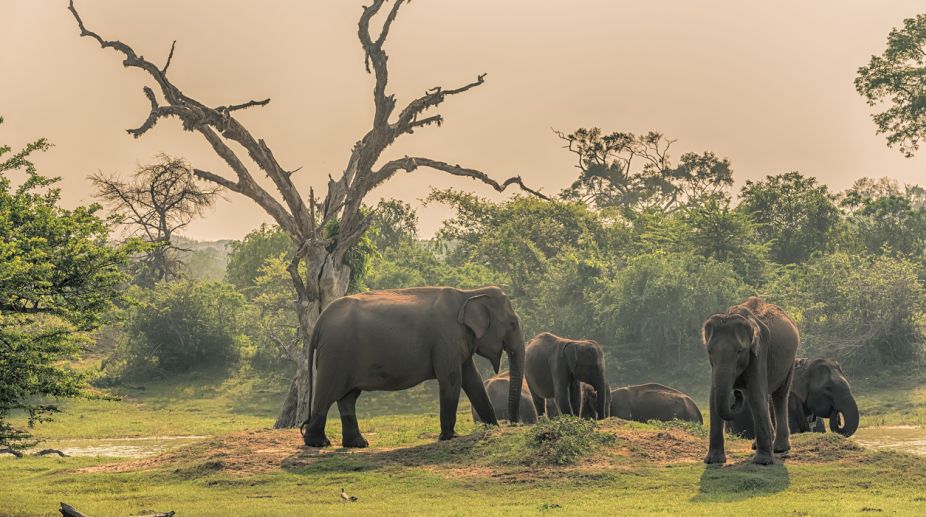PM Modi lauds Assam’s ‘Hathibandhu’ initiative in his Mann Ki Baat address
Prime Minister Narendra Modi praised Assam’s innovative 'Hathibandhu' initiative for mitigating human-elephant conflict during his monthly Mann Ki Baat address on Sunday.

Representational Image (Photo: Getty Images)
An adult elephant, it is estimated, eats from 500 lbs to 600 lbs of green fodder daily. This estimate is based on experiments conducted by Sanderson and others on well-fed tame elephants, and while it is generally unsound equating the habits and behaviour of captive animals with others of their kind living free, this is the only basis we have for assessing the quantity of green fodder consumed by a wild elephant in a day.
That apart, actual observation of wild elephants shows that much of the waking life of the great beasts is spent in feeding. It should be realised that elephants do not graze or browse as most ruminants do, quickly eating up what they get, but are deliberate and choosy in their feeding. Grass is plucked out in a bundle, dusted against the knee to free it from adherent earth, and then placed crosswise in the mouth with the roots and lower stalks, and the leaf tips projecting from either side of the jaws; the roots and basal culms, or the roots alone and the blades, are then severed and rejected at one bite, depending on whether the grass is fresh or not and whether the culms are juicy; the mouthful is then masticated and swallowed, and then another clump of grass investigated and pulled out.
Advertisement
Tall grass of many kinds and tree foliage are the bulkiest fodder that elephants eat, but even when feeding on these they take a long time picking and choosing, dusting and rejecting, and then finally chewing up what they wish to eat. Moreover, they like variety in their diet and will often search long and patiently for some titbit that they specially fancy. I have seen a big wild tusker spend well over an hour in plucking the tiny, pink heads of the flowers from a patch of Mimosa pudica, and carefully conveying them to his mouth.
Advertisement
It is usually said that wild elephants are very wasteful in their feeding and trample down more than they eat. This is not true. This mistaken belief arises from the behaviour of wild elephants then raiding crops or when feeding near human habitations, when they fear intrusion from men. They dislike, with excellent justification, all the things that represent human intrusions into their old homes, and will pull down huts and posts erected by men. And when feeding in an area where they apprehend disturbance and harassment by men they are very noisy and wasteful.
In the deeper jungles, as I know from repeated careful observation, they are extremely tidy and economical in their feeding, and do not trample down the vegetation indiscriminately-in fact, except that I had watched a large herd for days in a certain locality, I could not have believed that so many elephants had fed there-their trails, suggested half-a-dozen beasts and not over 40, because they had trodden in one anothers’ footsteps.
It is a well-known fact that no jungle area, however small, has ever perished in our country by elephants or other large wild animals destroying or consuming the vegetation: it is no less well known that entire forests, several square miles in area, have disappeared and been converted into barren ground within two or three years by human depredation.
To give some idea of the wide variety of the natural diet of elephants I provide a list which is, I repeat, only indicative and not comprehensive. This takes no note of what tame elephants eat (I know one that has a passion for chewing gum!), and of cultivated crops like sugarcane and millets.
Bamboo is much eaten, and elephants in company often pull down an entire clump to get at the less woody culms; however, no great damage is done thereby, as the aerial shoots come up again from the rhizomes. Tall grasses of several kinds, pandanus, the dwarf date palm (Phoenix humilis), and some plants of the arrowroot and ginger families that cover the forest floor in moist localities, are all part of the regular fodder of elephants. The succulent shrub, Ardisia solanacea provides them with water when the summer is dry-it grows in brakes by forest streams.
A number of shrubs, such as Helicteres isora and Hibiscus lampas serve to vary the fodder, and among the trees whose foliage they specially like are species of Albizzia, Zizyphus trinervia, and Grewia tiliaefolia-Diospyros melanoxylon foliage when tender is greatly fancied, and in elephant jungles one often sees young trees of this species pollarded by the beasts making a clean sweep of the crowns. The young shoots of teak and the bark of Grewia species and especially of Kydia calycina, are also much relished.
Quite a few fruits, such as those of the screwpine, wild date, Careya arborea, Terminalia bellerlca, and species of Emblica are great favourites with wild elephants. Regarding the last, my experience has been that while some wild elephants like the “nelli” fruit (“amla”), some do not seen to care for it-the fruit is usually picked from the ground, when ripe and fallen, and not plucked from the “nelli” trees.
This was published on 3 April 1967.
Advertisement